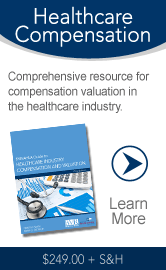 |
 |
Issue #13-1 | June 17, 2013

|
Tying physician pay to quality gains steam The use of quality measures is a small but emerging component of total compensation for physicians. But in the future, as reimbursement becomes tied more closely with quality and cost measures, compensation for doctors will follow suit. First look: The MGMA Physician Compensation and Production Survey: 2013 Report Based on 2012 Data reveals that primary care physicians have 3% of their total compensation based on quality measures. Specialists reported that 2% of their total compensation was based upon quality metrics. For the first time in a national survey of this size, MGMA-ACMPE has gathered and reported data within the compensation report regarding quality and patient satisfaction metrics. Physicians responding to the MGMA survey also reported that patient satisfaction played a small role in their compensation, likely a result of the industry’s shift toward patient-centered care. “Quality and patient satisfaction metrics are not yet dominant components of physician compensation plans right now; however, as reimbursement models continue to shift, the small changes we’ve observed recently will gain momentum,” explained Susan L. Turney, MD, MS, FACMPE, FACP, MGMA-ACMPE president and CEO. “It’s encouraging to see physician practices invested in patient-centered care and continuing to seek ways to better incorporate quality and experience into compensation methodologies.” The report also indicated that median compensation for physicians fluctuated by specialty. Primary care physicians reported $216,462 in median compensation, and specialists reported $388,199 in median compensation (both figures have been adjusted for inflation). Hospitals rein in readmissionsWith the prospect of reduced Medicare reimbursements for high rates of readmissions under the Affordable Care Act, it appears that hospitals are working to reduce readmissions. The average 30-day hospital readmission rate fell in calendar year 2012, according to a new analysis by the Centers for Medicare & Medicaid Services. Based on claims processed to date, the average all-cause readmission rate declined from 19% to 18.4% for hospitals participating in the Partnership for Patients program, and from 19.2% to 18.6% for other hospitals, CMS says. That translates to about 70,000 fewer readmissions for the year. Regional rates vary widely but have not been adjusted to account for differences in demographic factors or risk profiles, limiting the ability to make direct comparisons between different areas, CMS said. What to do: To reduce readmissions, consider these strategies: implement improvements to transitional care, such as a nurse-led discharge process and follow-up phone calls, or use electronic medical records to identify and better manage high-risk patients, such as those subject to heart failure. Refocus thinking on commercial reasonableness of transactionsTransactions that healthcare organizations enter into are subject to regulatory review that scrutinizes both the commercial reasonableness and fair market value. The Stark Law, the anti-kickback statute, the False Claims Act, and Internal Revenue Service 501(c)(3) status all include regulations and sanctions that come into play. More attention: The issue of commercial reasonableness has gained increasing importance in assessing the valuation of both the healthcare business itself and compensation arrangements. There is no consensus about what is commercially reasonable, how to assess it, and who should do the assessing. Also, there needs to be a shift of focus on how this concept is approached, especially in light of increased government attention and a flood of court cases. “It is my view, and this comes from my practice and the large quantity of review work that I do, that the focus on both the compensation opinion side as well as the business valuation side has been much more heavily at the Stark Law and the Anti-Kickback Statute,” says Mark Dietrich. “It has really not taken into account to a necessary extent the tax rules, particularly those around Section 162, Ordinary and Necessary Business Expense, as that applies to compensation deductions.” Dietrich, a top expert on healthcare valuation, is editor and contributing author to the Business Valuation Resources/AHLA Guide to Healthcare Valuation.He spoke at a recent BVR webinar on commercial reasonableness and fair market value in a healthcare industry context. Several court cases, including the recent Tuomey case (see the May 16 issue of Healthcare Value Wire), have emerged on this issue. In the Tuomey case, a federal jury found a nonprofit hospital guilty under the Stark Law of providing illegal kickbacks to a group of local doctors under part-time employment contracts that the government said paid well above fair market value. This case underscores the importance of taking into account the courts’ views on commercial reasonableness and fair market value. “I believe in the end that where we as appraisers draw the fair market value line ought to be responsive to where the courts believe the fair market value line should be drawn,” says Dietrich. Assessing readiness for bundled payments Is now the time for your organization to spearhead a bundled payments (BP) program? This is a hot topic of discussion, but the practice has yet to hit the mainstream. Government and commercial payers are pushing the idea, but many healthcare providers don’t think the time is right—yet. A new report from the Robert Wood Johnson Foundation outlines four action steps community providers can take to determine whether it is the right time to kick off a BP program. 1.Define the focus. This is the point at which the impact of a BP program should be considered within the context of other payment reform initiatives in your community, such as accountable care organizations or shared savings programs. Is your community ready for a big project? Would it prefer a small one? Can a BP program start in your community with just one or a few providers, or is widespread participation necessary? Do you want to look at one or two procedures or conditions, or do you want to attack many procedures and conditions at once? 2. Analyze the data. Interpreting data is becoming the order of the day for healthcare leaders. For example, use utilization and price/cost patterns in your community to identify opportunities for cost control and quality improvement. Also, look at other payment reform programs underway in your community. Is there a certain area in which BP would be particularly appropriate? 3. Negotiate the deal. Determine a case rate and allow for a margin—a price that is “fair” so that both providers and payers have incentive to participate. Build in an extra payment (or a penalty) for meeting (or not meeting) quality goals based on measurable results. 4. Figure out the small stuff. There are details to be considered, such as stop-loss levels and communication plans. These need to be dealt with at the front end, before a program rolls out, if possible. |
|
||||||
1000 SW Broadway, Suite 1200, Portland, OR 97205
(503) 291-7963 | editor@bvhealthcarenews.com
www.BVResources.com/healthcare

